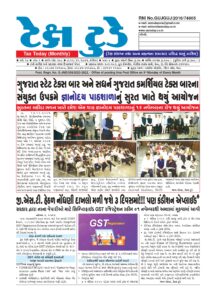GST WEEKLY UPDATE :27/2025-26 (05.10.2025) By CA Vipul Khandhar

-By CA Vipul Khandhar
- Invoice Management System (IMS) – Effective from October 2025:
In an era of increasing digital compliance and real-time data integration, the introduction of the Invoice Management System (IMS) marks a significant leap toward enhanced transparency, efficiency, and automation in business transactions. Effective from October 2025, this new system aims to streamline the end-to-end process of invoice generation, verification, reporting, and compliance under the GST framework.
Objective of the New System
The primary objective of the Invoice Management System is to create a centralized digital ecosystem for all invoices—whether issued, received, or modified—allowing businesses and tax authorities to:
- Ensure real-time invoice validation and reduce discrepancies.
- Enable seamless data flow between suppliers, recipients, and the GST portal.
- Minimize invoice mismatches and input tax credit (ITC) disputes.
Support automation in reconciliation and compliance reporting.
Key Features
- Centralized Invoice Repository: All business-to-business (B2B) and specified business-to-consumer (B2C) invoices will be uploaded to a unified portal, ensuring easy traceability and auditability.
- Integration with GST & E-Invoicing Systems: IMS will integrate directly with existing GSTN and e-invoice portals, ensuring auto-population of invoice data in GSTR-1, GSTR-2B, and other relevant forms.
- Automated Reconciliation: The system will automatically match invoices between suppliers and recipients, reducing manual intervention and saving significant time during return filing.
- Enhanced Data Accuracy & Fraud Detection: With real-time validation and digital verification, IMS will help detect fake invoices, duplicate entries, and fraudulent ITC claims.
- User-Friendly Interface & API Support: Businesses can connect their ERP/accounting systems directly with IMS using secure APIs for smooth, automated uploads and downloads of invoice data.
Implementation Timeline
- October 2025: System goes live for all registered taxpayers with annual turnover above the prescribed threshold.
Phase II (January 2026): Gradual extension to medium and small taxpayers to ensure smoother adoption.
Impact on Businesses
The implementation of IMS will bring transformative benefits, including:
- Reduced compliance burden through auto-populated returns.
- Faster ITC reconciliation and fewer disputes.
- Improved business analytics with structured invoice data.
- Stronger compliance discipline and reduced risk of penalties.
However, businesses will need to upgrade their internal accounting software, train staff on new processes, and ensure data accuracy for seamless integration.
Preparation Steps for Businesses
- System Upgrade: Ensure ERP/accounting software is compatible with the IMS API framework.
- Data Clean-Up: Review and validate existing supplier and customer records.
- Training: Educate finance and compliance teams on the new workflow.
Testing: Conduct trial uploads before the effective date to ensure readiness.
Conclusion
The Invoice Management System (IMS) represents a major step in India’s journey toward digital governance and tax transparency. By leveraging technology, it promises to simplify compliance, reduce fraud, and enhance the ease of doing business. As the system goes live from October 2025, businesses must proactively adapt to harness its full benefits and remain future-ready in the evolving digital tax ecosystem.
- The Provisional sanction of refund claims:
Implementation of Risk-Based Processing of Refund Applications – Effective from 1st October 2025
In line with the Government’s continuous efforts toward trade facilitation and faster refund disbursal, the Central Board of Indirect Taxes and Customs (CBIC) has introduced a risk-based mechanism for processing GST refund applications, effective 1st October 2025, as notified under Notification No. 13/2025–Central Tax dated 17.09.2025.
1. Key Highlights of the New Refund Processing Framework
- Refunds to continue under existing guidelines till issuance of FORM GST RFD-02 (Acknowledgement) or FORM GST RFD-03 (Deficiency Memo), within the prescribed timelines.
- System-based Risk Categorization: Refund applications will now be categorized as “low-risk” or otherwise, based on automated risk scores generated by the system.
- Provisional Refund for Low-Risk Applicants:
- 90% of the claimed refund amount shall be sanctioned on a provisional basis for applications identified as low-risk.
- No further scrutiny is required before sanctioning provisional refund unless covered under the proviso to Rule 91(2) of the CGST Rules, 2017.
- Detailed Scrutiny for Non–Low-Risk Cases:
Refunds not categorized as low-risk will be processed under detailed examination as per existing procedures.
2. Statutory and Procedural Safeguards
- All statutory conditions under Section 54(6) of the CGST Act and Rule 91(1) remain applicable, including non-prosecution requirements and exclusion of notified categories.
- No withholding or adjustment of provisionally sanctioned amounts under Sections 54(10) and 54(11).
- In cases where refund amounts are under dispute or pending in appeal, provisional refund should not be granted.
- The proviso to Rule 91(2) should be invoked sparingly, ensuring trade facilitation remains the guiding principle.
3. Post-Sanction Verification
If, upon final scrutiny, the amount provisionally refunded exceeds the admissible refund, the proper officer shall issue a show cause notice in FORM GST RFD-08 under Section 54, read with Sections 73/74/74A, to recover the excess amount.
4. Extension to Inverted Duty Structure (IDS) Refunds
Pending legislative amendments, as an interim facilitation measure, refund applications filed on account of Inverted Duty Structure (IDS) on or after 01.10.2025 will also be eligible for 90% provisional refund sanction, similar to zero-rated supply cases.
- The same manner of processing (Para 3.1–3.4) and statutory conditions applicable to zero-rated refunds will apply to IDS refund cases.
- GSTN has enabled the corresponding system functionality for issuance of such provisional refunds.
5. Monitoring and Oversight
Implementation of these instructions will be closely monitored by jurisdictional Principal Commissioners/Commissioners, who shall report to their respective Principal Chief Commissioners/Chief Commissioners. The supervisory authorities are expected to ensure that these trade facilitation measures are executed in letter and spirit.
Effective Date: 1st October 2025
Reference Notifications:
- Notification No. 13/2025 – Central Tax dated 17.09.2025
- Notification No. 14/2025 – Central Tax dated 17.09.2025
- Withdrawal of Circular on Evidence for Compliance under Section 15(3)(b)(ii) of the CGST Act, 2017 Effective Date: October 01, 2025 CBIC Circular No. 253/10/2025-GST dated October 01, 2025:
The Central Board of Indirect Taxes and Customs (CBIC) has issued Circular No. 253/10/2025-GST dated October 01, 2025, withdrawing Circular No. 212/6/2024-GST dated June 26, 2024, which had earlier prescribed the procedure for providing evidence of compliance under Section 15(3)(b)(ii) of the Central Goods and Services Tax (CGST) Act, 2017.
Background: Circular No. 212/6/2024-GST (Dated 26th June 2024)
The withdrawn Circular No. 212/6/2024-GST was issued to clarify the mechanism for suppliers to demonstrate compliance with the conditions laid down in Section 15(3)(b)(ii) of the CGST Act, 2017.
This provision deals with discounts or post-supply price reductions, allowing suppliers to reduce the taxable value only when certain conditions are met, namely:
- The discount is established in terms of an agreement entered into at or before the time of supply;
- The recipient reverses the proportionate input tax credit (ITC) corresponding to the discount received.
To operationalize these provisions, Circular No. 212/6/2024-GST had required suppliers to maintain and submit specific documentary evidence proving that:
- The agreement for post-supply discounts existed prior to supply;
- The recipient had duly reversed the corresponding ITC; and
- The supplier had adjusted the taxable value and tax in the relevant return accordingly.
While intended to ensure compliance and prevent misuse of discount-based adjustments, the earlier circular was viewed as creating additional procedural burdens for taxpayers and field officers, leading to interpretational challenges and inconsistent practices across jurisdictions.
Analytical Insight
The withdrawal of Circular No. 212/6/2024-GST marks a significant move toward procedural simplification and trust-based compliance under GST.
- The earlier circular’s requirement for documentary evidence had led to variations in interpretation by different field formations and increased compliance cost for suppliers, especially in sectors where post-supply discounts are common (e.g., FMCG, automotive, pharma).
- By removing the evidentiary requirement, CBIC has aligned the implementation with the principle of self-assessment under GST, while still retaining the authority to verify compliance during audits or assessments if needed.
This step enhances ease of doing business, reduces documentation-related disputes, and promotes a uniform nationwide approach.
Action Points for Trade and Officers
- Field formations: Issue trade notices to disseminate the circular’s content widely.
- Taxpayers: Note that submission of separate evidence under Section 15(3)(b)(ii) is no longer required.
Officers: Continue to verify compliance during audit or scrutiny, if warranted, but not as a precondition for acceptance of discounts.
- Important Judgements:
(i) Gauhati Highcourt Decision Regarding Form GST ASMT-10 notice mandatory before issuing SCN u/s 73 for returns scrutiny”
(Applicant – PepsiCo India Holdings Pvt. Ltd. vs. UOI & 3 Ors. [WP(C)/6960/2023]
The Court held that initiation of proceedings under Section 73 must be preceded by scrutiny of returns under Section 61. This requires issuance of Form GST ASMT-10 to confront discrepancies. Since this was not done, the SCN was deemed without jurisdiction.
Revenue’s failure to issue Form ASMT-10 before proceeding under Section 73 was considered a clear violation of statutory procedure. The HC relied on Rajasthan HC in Goverdhandham Estate (affirmed by SC) to declare such action unauthorized and void.
The SCN was based on mismatch between the annual return and reconciliation statement due to non-furnishing of Table 14 of GSTR-9C. Since filing Table 14 was optional for FY 2017-18, absence of such data could not legally constitute a discrepancy.
The Court emphasized that GST is a self-assessment regime. Verification of correctness of returns can only be done through Section 61 scrutiny, and any conclusion of wrongful ITC availment must flow from this process. Without following it, Section 73 jurisdiction cannot be assumed.
As the Revenue invoked Section 73 without complying with mandatory Section 61 procedures, the HC ruled the entire proceedings—including the SCN for ITC mismatch of ₹19.5 crores—unauthorized and contrary to law.
Disclaimer:
This publication contains information for general guidance only. It is not intended to address the circumstances of any particular individual or entity. Although the best of endeavour has been made to provide the provisions in a simpler and accurate form, there is no substitute to detailed research with regard to the specific situation of a particular individual or entity. We do not accept any responsibility for loss incurred by any person for acting or refraining to act as a result of any matter in this publication.





